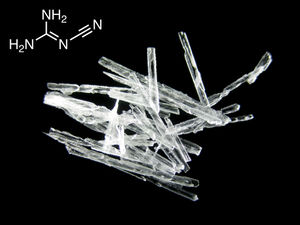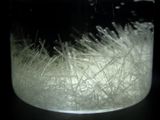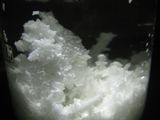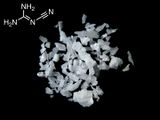Difference between revisions of "Cyanoguanidine"
Diachrynic (Talk | contribs) |
Diachrynic (Talk | contribs) |
||
| Line 120: | Line 120: | ||
'''Dicyanamide''' or '''2-cyanoguanidine''' (IUPAC name), is an organic chemical compound, a nitrile derived from [[guanidine]]. It is a dimer of [[cyanamide]], with the formula '''C<sub>2</sub>H<sub>4</sub>N<sub>4</sub>'''. | '''Dicyanamide''' or '''2-cyanoguanidine''' (IUPAC name), is an organic chemical compound, a nitrile derived from [[guanidine]]. It is a dimer of [[cyanamide]], with the formula '''C<sub>2</sub>H<sub>4</sub>N<sub>4</sub>'''. | ||
| − | The name "2-cyanoguanidine" or just "cyanoguanidine" is often chosen for this compound in literature, as dicyanamide (also known as dicyanamine) is also the name for the anionic species [N(CN)<sub>2</sub>]<sup>−</sup> | + | The name "2-cyanoguanidine" or just "cyanoguanidine" is often chosen for this compound in literature, as dicyanamide (also known as dicyanamine) is also the name for the anionic species [N(CN)<sub>2</sub>]<sup>−</sup>, which may form 2-cyanoguanidine on addition of ammonia. |
==Properties== | ==Properties== | ||
| Line 126: | Line 126: | ||
Two tautomeric forms exist (1-cyanoguanidine and 2-cyanoguanidine), differing in the protonation and bonding of the nitrogen to which the nitrile group is attached. | Two tautomeric forms exist (1-cyanoguanidine and 2-cyanoguanidine), differing in the protonation and bonding of the nitrogen to which the nitrile group is attached. | ||
| − | 2-Cyanoguanidine can also exist in a zwitterionic form via a formal acid–base reaction among the nitrogens. | + | 2-Cyanoguanidine can also exist in a zwitterionic form via a formal acid–base reaction among the nitrogens. |
Cyanoguanidine reacts with [[dimethylamine]] at high temperatures to yield the anti-diabetic drug [[metformin]]. | Cyanoguanidine reacts with [[dimethylamine]] at high temperatures to yield the anti-diabetic drug [[metformin]]. | ||
Revision as of 12:31, 17 August 2023
 Magnified crystals of dicyanamide
| |
| Names | |
|---|---|
| IUPAC name
2-Cyanoguanidine
| |
| Other names
1-Cyanoguanidine
2-Cyanoguanidine DCD Dicy Dicyandiamide Dicyanodiamide Didin Guanidine-1-carbonitrile N-Cyanoguanidine | |
| Properties | |
| C2H4N4 (H2N)2C=N-CN | |
| Molar mass | 84.08 g/mol |
| Appearance | White crystalline solid |
| Odor | Odorless |
| Density | 1.404 g/cm3 (20 °C)[1] |
| Melting point | 209–212 °C (408–414 °F; 482–485 K) [6] |
| Boiling point | 252 °C (486 °F; 525 K) |
| 1.283 g/100 ml (0 °C) 3.101 g/100 ml (20 °C) 4.762 g/100 ml (30 °C) 7.236 g/100 ml (40 °C) 15.97 g/100 ml (60 °C) 27.54 g/100 ml (80 °C)[2] | |
| Solubility | Somewhat soluble in alcohols Poorly soluble in acetone Insoluble in chloroform, ethers, hydrocarbons |
| Solubility in acetone | 1.7 g/100 ml (30 °C) 2.2 g/100 ml (50 °C)[3] |
| Solubility in benzene | 0.008 g/100 ml (30 °C) |
| Solubility in diethyl ether | 0.0006 g/100 ml (0 °C) 0.0015 g/100 ml (25 °C) 0.0026 g/100 ml (35.3 °C)[4] |
| Solubility in ethanol | 0.937 g/100 ml (0 °C) 1.26 g/100 ml (13 °C) 1.70 g/100 ml (26.4 °C) 2.26 g/100 ml (35 °C) 3.30 g/100 ml (49.9 °C) 4.13 g/100 ml (60.1 °C)[5] |
| Solubility in methanol | 3.46 g/100 ml (1 °C) 4.88 g/100 ml (20 °C) 5.63 g/100 ml (29.5 °C) 7.45 g/100 ml (39 °C) 12.35 g/100 ml (63 °C)[5] |
| Vapor pressure | ~0 mmHg |
| Thermochemistry | |
| Hazards | |
| Safety data sheet | Sigma-Aldrich |
| Flash point | Non-flammable |
| Lethal dose or concentration (LD, LC): | |
| LD50 (Median dose)
|
30,000 mg/kg (rat, oral) 1,000 mg/kg (mouse, oral) |
| Related compounds | |
| Related compounds
|
Cyanamide Guanidine |
| Except where otherwise noted, data are given for materials in their standard state (at 25 °C [77 °F], 100 kPa). | |
| Infobox references | |
Dicyanamide or 2-cyanoguanidine (IUPAC name), is an organic chemical compound, a nitrile derived from guanidine. It is a dimer of cyanamide, with the formula C2H4N4.
The name "2-cyanoguanidine" or just "cyanoguanidine" is often chosen for this compound in literature, as dicyanamide (also known as dicyanamine) is also the name for the anionic species [N(CN)2]−, which may form 2-cyanoguanidine on addition of ammonia.
Contents
Properties
Chemical
Two tautomeric forms exist (1-cyanoguanidine and 2-cyanoguanidine), differing in the protonation and bonding of the nitrogen to which the nitrile group is attached.
2-Cyanoguanidine can also exist in a zwitterionic form via a formal acid–base reaction among the nitrogens.
Cyanoguanidine reacts with dimethylamine at high temperatures to yield the anti-diabetic drug metformin.
Reaction of 2-cyanoguanidine with hydrazine sulfate yields guanazoguanazole.
Physical
2-Cyanoguanidine is a white crystalline solid, soluble in hot water, and somewhat soluble in methanol and ethanol, but not nonpolar organic solvents. It can take on various crystal shapes such as needles, rhombus and scales.[9]
Availability
2-Cyanoguanidine is sold by chemical suppliers.
Preparation
Dicyanamide can be prepared by treating cyanamide with base, as cyanamide dimerizes at high pH.
- 2 H2N-CN → (H2N)2C=N-CN
The simplest route, which encapsulates the reaction above, can be achieve by boiling calcium cyanamide fertilizer in water for 15 or 30 minutes. As this type of fertilizer already contains enough calcium oxide/hydroxide to make it strongly alkaline, the reaction proceeds directly from CaCN2 to dicyanamide.
- 2 CaCN2 + H2O + OH- → (H2N)2C=N-CN + 2 Ca2+ + OH-
After the boiling is complete, the fertilizer suspension is taken off the heat and filtered to remove the insoluble products. However, even if the resulting filtrate is clear, calcium hydroxide will still be present in said filtrate (solubility of Ca(OH)2 is 0.066 g at 100 °C and its solubility increases with the decrease in temperature), and thus needs to be removed, to prevent it from interfering with the recrystallization of cyanoguanidine. While it's possible to precipitate it by adding small amounts of dil. sulfuric or phosphoric acid, the best route to remove the dissolved calcium is by bubbling carbon dioxide into the filtrate. This will cause the calcium to precipitate out of the solution as calcium carbonate, and as a bonus will also remove the foul smelling sulfurous contamination. Thus, this step should be done either outside or in a fumehood. The pH should be measured throughout the process, and must be maintained at 8 or above. The filtrate is concentrated and then allowed to cool, which causes the cyanoguanidine to crystallize as rhombic crystal aggregates or needle-like crystals.
A good procedure was described by SM user Diachrynic: Commercial calcium cyanamide fertilizer prills containing around 50% CaCN2 with the rest being mostly calcium carbonate are boiled for 30 minutes with twice their weight in water, hot filtered and the filtrate left to crystallize. The needle shaped crystals are recovered and the filtrate reused for the next run, being topped off to the required volume. The yield is usually ~30% for the first extraction and around ~50% for subsequent runs. A more detailed description is provided in the forum thread here.
The reaction of thiourea with copper(II) oxide or copper(II) carbonate will yield dicyanamide.The procedure is described as following:
- 2 (H2N)2C=S + 2 CuO → (H2N)2C=N-CN + 2 CuS + H2O
152 g thiourea is added in 500 ml water, which is brought to boiling temperature. A total of 175 g CuO is added in portions. The suspension is boiled for 4 hours, and filtered off, to remove the precipitated CuS and residual CuO. The filter cake is further washed with a small portion of hot water and filtrate was evaporated until colorless prism crystals started to form. Total yield: 77 g (92%). The mother liquor contains some residual dicyandiamide and thiourea, which can be reused.[10]
Projects
- Make various guanidine derivates
- Make metformin
- Slow fertilizer
- Curing agent for epoxy resins
Handling
Safety
2-Cyanoguanidine is irritant to eyes, lungs and nose. The compound does not appear to induce serious health risks. There is no clear evidence that it may increase the risk of organ damage, cancer, reproductive issues or neurological damage.
Cyanoguanidine displays antimicrobial properties, by interfering with the synthesis of folic acid, which inhibits the growth of bacteria. This inhibits the production of DNA and protein, thereby leading to cell death.
Dicyanamide is not flammable and will not ignite even in contact with red hot metal. Mixtures with an oxidizer, like potassium nitrate, will react.[11]
Storage
Should be kept in closed plastic or glass bottles.
Disposal
No special disposal is required. The compound can be used as fertilizer, if diluted.
Several studies have shown that was cyanoguanidine completely biodegraded within 34 weeks under aerobic conditions, while two-thirds of the total was biodegraded within 60 weeks under anaerobic conditions.[12] Microorganisms will readily degrade this compound to non-hazardous byproducts.[13]
Gallery
References
- ↑ Hughes; Journal of the American Chemical Society; vol. 62; (1940); p. 1259
- ↑ Yalkowsky S.H., Yan H., Jain P. Handbook of aqueous solubility data. – 2nd ed. - CRC Press, 2010
- ↑ Вирпша З., Бжезиньский Я. Аминопласты. - М.: Химия, 1973 pp. 20 (Virpsha Z., Brzezinski J. Amino plastics - M.: Chemistry, 1973 pp. 20)
- ↑ Seidell A. Solubilities of organic compounds. - 3ed., vol.2. - New York: D. Van Nostrand Company, 1941
- ↑ 5.0 5.1 'Бьюкенен Дж. Г. Цианистые соединения и их анализ. - Л., 1933 (J. Grant Buchanan, Cyanide compounds and their analysis. - L., 1933)
- ↑ Singh, L. Jaideva; Singh, R. K. Hemakumar; Chemical Papers; vol. 68; nb. 2; (2014); p. 223 - 232
- ↑ Stephenson; Berets; Journal of the American Chemical Society; vol. 74; (1952); p. 882
- ↑ Salley; Gray; Journal of the American Chemical Society; vol. 70; (1948); p. 2652
- ↑ Ji-Biao Zhang, Zhi-Cheng Tan, Shuang-He Meng, Shao-Hui Li, Li-Ming Zhang, Thermochimica Acta 1997, 307, 1, 11-15, https://doi.org/10.1016/S0040-6031(97)00323-7
- ↑ Hausigk, D.; Chemische Berichte; vol. 103; (1970); p. 325 - 326
- ↑ https://echa.europa.eu/registration-dossier/-/registered-dossier/15751/4/14
- ↑ Amberger, V. A. and Vilsmeier, K.: Untersuchungen zur Auswaschung von Dicyandiamid und dessen Abbau in Ueberstauten Boeden, Z. Wasser-AbwasserForsch, 21, 140-144(1988)
- ↑ Hallinger, S., Wallnoefer, P. R., Goldbach, H. and Amberger, A. (1990). Naturwissenschaften. 77, 332-334


